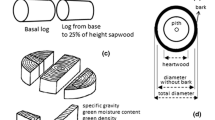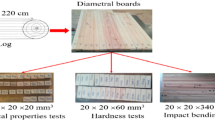Summary
Preliminary investigations of the interaction occurring between different timber species and various types of steel used for sawblade manufacture, have indicated clearly the practical importance of the process of stress corrosion cracking (Krilov 1986). Based on eight timber species and four types of steel, these have confirmed the previous findings, indicating that the losses of material can be very extensive. The results of the combined effects of corrosion and wear produced steel losses ranging from 3.3 to 8.4 g/m2/h in weight and 0.0008 to 0.002 mm/h in thickness of the sawblade. The interaction between timber species and the types of steel was highly significant. The corrosion losses caused by the ‘stringybark’ species, Eucalyptus obliqua, E. muellerana and E. macrorhynca were >37% greater than those produced by species not belonging to this botanical classification. Both timber and steels were ranked by Duncan's multiple-range test according to their corrosive properties, which differed at 5% probability level. These findings have practical applications in the woodworking industry and related fields.
Similar content being viewed by others
References
Krilov, A. 1986: Corrosion and wear of sawblade steels. Wood Sci. Technol. 20: 363–370
Krilov, A.; Gref, R. 1986: Mechanism of sawblade corrosion by polyphenolic compounds. Wood Sci. Technol. 20: 371–378
Author information
Authors and Affiliations
Rights and permissions
About this article
Cite this article
Krilov, A. Corrosive properties of some Eucalypts. Wood Sci. Technol. 21, 211–217 (1987). https://doi.org/10.1007/BF00351392
Received:
Issue Date:
DOI: https://doi.org/10.1007/BF00351392




